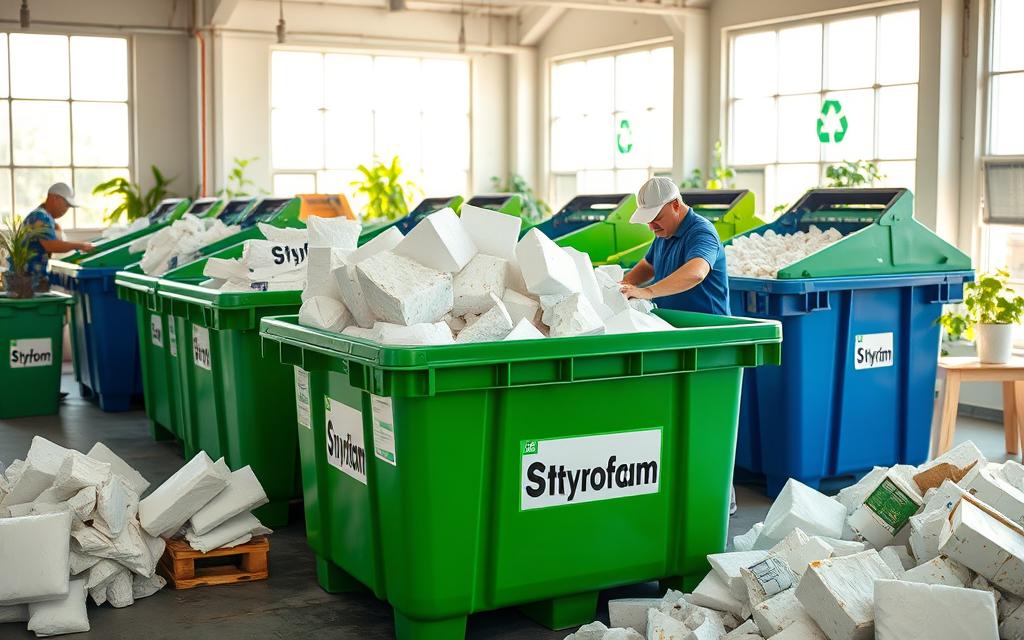Table of Contents
Can you recycle Styrofoam? This is a question many people ask when they see leftover Styrofoam cups, food containers, or packaging. Styrofoam is lightweight and useful, but it can also be a big problem for the environment. Many people don’t know if it belongs in the recycling bin or the trash.
Styrofoam is a type of plastic, but not all plastics are the same. Some recycling centers accept Styrofoam, while others do not. It depends on the type of Styrofoam and where you live. Understanding the right way to recycle or dispose of Styrofoam can help reduce waste and protect the planet.
What Is Styrofoam and Why Is It Everywhere?
Styrofoam is a type of plastic that is light and cheap. It is used for many things like food containers, cups, and packaging. Since it is strong and keeps things warm or cold, people use it a lot in daily life.
This material is made from tiny plastic beads that are expanded with air. That’s why it feels soft but firm. Many companies use Styrofoam because it is easy to make and does not cost much. But the big problem is that it does not break down easily in nature.
You can find Styrofoam in homes, offices, and stores. It is used in takeout food boxes, coffee cups, and even furniture packaging. Since it is so common, it is important to know what to do with it after use.
Can You Recycle Styrofoam? The Simple Answer
Many people wonder if they can recycle Styrofoam. The answer depends on where you live. Some recycling centers accept it, but most do not because it is hard to process.
Styrofoam is made of expanded polystyrene (EPS), which is not like normal plastic. It takes a lot of effort to clean and recycle it properly. This is why most cities ask people to throw it in the trash instead of the recycling bin.
Before recycling, check with your local recycling center. Some places have special drop-off locations where you can take used Styrofoam. This helps keep it out of landfills and reduces waste.
Why Is Recycling Styrofoam So Difficult?
Recycling Styrofoam is not easy because it is mostly made of air. Since it is so light, it takes up a lot of space but has very little actual plastic in it. This makes it expensive to collect and transport.
Styrofoam also absorbs food, oil, and dirt, making it harder to recycle. If it is not clean, recycling centers cannot use it. This is why most food containers made of Styrofoam end up in landfills.
Another reason is that not all machines can recycle it. Many recycling plants are designed for hard plastics like bottles and containers, but Styrofoam needs special equipment. This is why it is not accepted everywhere.
Types of Styrofoam: Which Ones Can Be Recycled

Not all Styrofoam is the same. Some types can be recycled, while others cannot. It is important to check the number on the bottom of the product.
- EPS (Expanded Polystyrene): This is the common white foam used in food containers and packaging. It is hard to recycle.
- XPS (Extruded Polystyrene): This is a stronger type of foam, often used for insulation. Some recycling centers accept it.
- Biodegradable Foam: Some new types of foam are made from plants and break down naturally. These are better for the environment.
If your local center accepts Styrofoam, they will usually ask you to clean it first. Removing any food, oil, or dirt makes it easier to recycle.
Where Can You Recycle Styrofoam?
Finding a place to recycle Styrofoam can be tricky. Many regular recycling bins do not accept it, but there are other options.
Some cities have special drop-off centers where you can take clean Styrofoam. These centers use machines to break it down and turn it into new products.
Grocery stores and packaging stores sometimes collect Styrofoam, especially packing peanuts. They reuse them instead of throwing them away. You can also check online to find the nearest place that accepts it.
Styrofoam vs. Other Plastics: What Makes It Different?
Styrofoam is different from other plastics because it is made with air. This makes it lighter but also harder to recycle. Unlike plastic bottles, Styrofoam is not easy to melt and reshape.
Another problem is that Styrofoam breaks into small pieces easily. These tiny bits can pollute water and harm animals. This is why some places have banned it.
Even though Styrofoam is useful, it is one of the hardest plastics to recycle. Many experts suggest using other materials instead.
How Businesses Handle Styrofoam Waste

Many businesses use Styrofoam every day, but they also try to reduce waste. Some have stopped using it completely, while others have found ways to recycle it.
Some companies use compactors to crush Styrofoam and make it easier to recycle. Others have switched to eco-friendly packaging made from paper or plants.
Businesses that ship products often reuse Styrofoam instead of throwing it away. They encourage customers to return used packing materials for reuse.
Creative Ways to Reuse Old Styrofoam
If you cannot recycle Styrofoam, you can still find ways to reuse it. Many people use it for craft projects, home insulation, and gardening.
- Arts and Crafts: You can cut Styrofoam into shapes for school projects or decorations.
- Packing Material: Save Styrofoam to protect fragile items when shipping or moving.
- Gardening: Break it into small pieces and mix it with soil to help plants grow better.
Reusing Styrofoam helps reduce waste and gives it a second life instead of sending it to the trash.
What Happens to Styrofoam in Landfills?
When Styrofoam goes to landfills, it stays there for hundreds of years. It does not break down like paper or food waste.
Since it is so light, it often blows away and ends up in rivers and oceans. Animals sometimes eat it, thinking it is food, which can be dangerous for them.
This is why reducing Styrofoam waste is important. Finding better ways to recycle or reuse it helps protect the environment.
The Future of Styrofoam Recycling: Is Change Coming?
Experts are looking for better ways to recycle Styrofoam. New technology is being developed to turn it into useful products.
Some companies are working on machines that can melt Styrofoam and reuse it. Others are creating eco-friendly materials that can replace it.
Governments are also making rules to reduce Styrofoam use. Some cities have banned it completely to cut down on waste.
How to Reduce Styrofoam Waste in Daily Life
- Use Reusable Cups and Containers instead of Styrofoam products.
- Avoid Buying Products with Styrofoam Packaging when possible.
- Find Alternative Packing Materials like paper or biodegradable foam.
Small changes in daily habits can help reduce the amount of Styrofoam waste. The more people choose eco-friendly options, the less Styrofoam will end up in landfills.
Eco-Friendly Alternatives to Styrofoam

Since Styrofoam is hard to recycle, many companies are looking for better alternatives. Some new materials work just as well but are safer for the environment.
- Paper-Based Packaging: Strong and recyclable, this is a good replacement for Styrofoam.
- Cornstarch Foam: This foam is biodegradable and breaks down in water.
- Mushroom Packaging: Made from natural fibers, it is safe and eco-friendly.
Switching to these materials can help reduce pollution and make recycling easier. Choosing eco-friendly products is one step toward a cleaner planet.
Conclusion
Styrofoam is everywhere, but it is not easy to recycle. Some places accept it, but most do not because it is hard to process. Since it does not break down easily, it can harm the environment if not handled properly.
The best way to reduce Styrofoam waste is to use less of it. Try to reuse it whenever possible, and look for eco-friendly alternatives. Small changes, like using paper or reusable cups, can help protect the planet for the future.
FAQs
Q: Can you recycle Styrofoam in your regular recycling bin?
A: No, most regular recycling bins do not accept Styrofoam. Check with your local recycling center for special drop-off locations.
Q: Why is Styrofoam so hard to recycle?
A: Styrofoam is mostly air, making it expensive to collect and process. It also absorbs food and dirt, which makes recycling difficult.
Q: What are some ways to reuse Styrofoam at home?
A: You can use Styrofoam for crafts, packing fragile items, or even as insulation for plants in winter.




